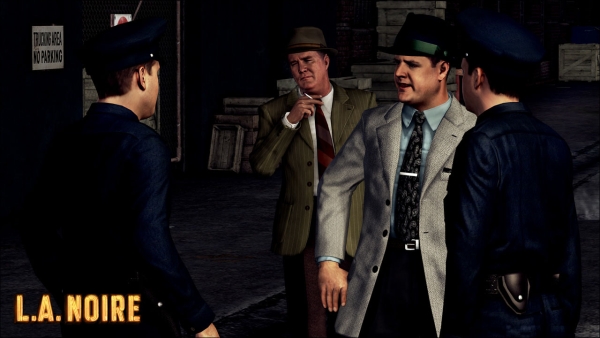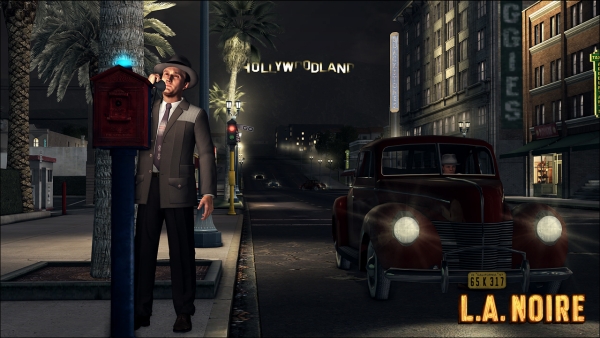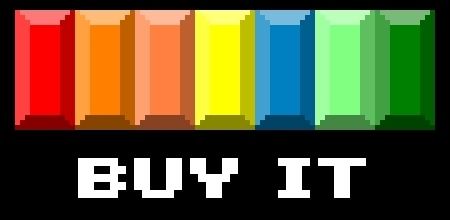
On the surface, L.A. Noire is an open-world detective game, in which you solve cases by gathering clues and interrogating suspects, working your way through the ranks of the various departments. But the game goes beyond that, allowing you to establish relationships with some characters while making rivals out of others. And underneath it all boils the subplot of their shared past, building a tension that froths through scene after scene. In a time when many argue over whether or not video games are art, or whether many have viable plots at all, L.A. Noire delivers a gripping story without sacrificing gameplay – and does all of this while feeling like a high-quality movie.
Platforms: PS3 (Version Played), Xbox 360
Publisher: Rockstar Games
Developer: Team Bondi, Rockstar Games
Genre: Film Noir Simulation
Release Date: May 17, 2011
ESRB Rating: Mature
The long-anticipated L.A. Noire opens exactly how you’d expect: the “Start” screen has a neon sign which flickers occasionally while a hearty jazz piece plays, immediately setting the mood for what’s to come. You play as Cole Phelps, a former Marine who is the newest member of the L.A.P.D. Phelps is good at working cases. He’s bright and has an uncanny intuition, and has a sense of nobility that many mistake for ambition. As you work your way across the departments, in and around Homicide and Vice, you’re also given glimpses into Phelps’ past – his time in World War II, where he fought alongside other soldiers who have relocated to L.A. and are now part of the present story. As the game progresses, the two storylines merge and are reconciled together.
The gameplay is an amalgam of things we’ve seen before, yet tied together here in a way that’s all its own. When Phelps inspects a crime scene, music plays in the background. When he gets near an object that might be a clue, there’s a musical indicator as well as a vibration in the controller. Once all the clues have been discovered, the music ends. Clues – as well as people of interest and locations you can visit – are all kept in a notebook, which Phelps can access and scroll through (while holding an ultra-sharp pencil). Once you’ve got a lead, you can use a phone to call the operator and get the information you need. Transportation between locations is in your car, which you can drive, or you can make your partner drive, allowing you to skip straight there – but cutting off your ability to answer calls from dispatch, which allow you to handle side missions. My favorite part about driving was getting directions from my partner, though in some cases, if you’re in the middle of a conversation that is part of the storyline, he’ll tell you at the very last moment, making you grind your teeth the way you do whenever the bad navigator is giving you directions but is too chatty to remind you where to turn.
Perhaps the most widely advertised functionality of L.A. Noire is the interrogation process, in which Phelps must size up the suspects and interpret their behavior. He then has to choose “Truth,” “Doubt,” or “Lie” – but choosing Lie means you need to have the proof to back it up. The motion capture of the characters’ faces is so detailed that you can see a nervous swallow or obvious movements of their eyes – general shiftiness that indicates all is not right. And I didn’t realize it at first, but the order of the information in your notebook isn’t necessarily the order of the questions to the suspect, so keep that in mind as well before you start grilling them. You have to choose the order of the questions, interpret their reactions, and interrogate them correctly (with proof, if necessary) for things to go your way.
On more than one occasion, things did not go my way.

It’s important not to get discouraged, as there are many opportunities to gain experience. You can also use “Intuition Points” to help you out with problems – during an interrogation, using one will remove one of the wrong options. (While investigating a crime scene, using one will expose all of the locations of the clues.) You can also ask the Rockstar Social Club for help with the “Ask the Community” feature. Once you’ve finished up all the parts of a case, you get a report at the end, telling you how much damage you’ve done, how many clues you collected, how many questions you got correct, what your star rating is, and what – if anything – you could have done better (for example, it tells you what a suspect would have told you if you’d interrogated them differently, or who got away because you didn’t follow up on a lead).
L.A. Noire plays well, looks good, and feels very intuitive. One of my favorite things about the game, as silly as it sounds, is how the characters look when they’re walking or running up and down the stairs. They tuck in their arms above the elbows and take the stairs easily, moving fluidly and gracefully. Another aspect I love is the fact that when you move your character towards a fence or a low wall, he jumps over it – there’s no prompt or extra button to push, he simply vaults himself over it. This is the same with ladders and drainpipes as well – climbing onto them is as simple as facing them and walking at them. So many small details – like moving pieces of laundry when you walk into a line of clothes hanging on a line – coupled with the big and small details of the time period, have created a game with an intimate and beautiful atmosphere.
It’s important to note how much the game feels like a film – so much so that it was featured at the Tribeca Film Festival, the first video game to appear there. The film noir style of the game can be enhanced even further by switching it to black and white mode, bringing in an even more distinctive 1940s feel. L.A. Noire redefines the concept of “style” when it comes to video games, bringing them to an entirely new level.

There’s just so much to love about this game. The characters are well-developed, especially Phelps, who has quickly become one of my favorite characters in a video game. As you learn more about his past and see why he reacts the way he does, he takes on dimensions rarely seen in a video game character. And as you play through the game, there are so many different types of gameplay – I felt like I was playing a mashup of Grand Theft Auto, Heavy Rain, and, at some points, Uncharted. I was chasing cars, finding clues, solving puzzles, and platforming, all with a strong character, great storyline, and solid gameplay. It’s a happy marriage, and it’s one that includes a great sense of humor: lines like “If you think I’m gonna climb through a broken window in a thirty dollar suit you’ve got another thing coming, buster” and “what were you thinking? You’ll be calling Richard Nixon a crook next!” had me laughing out loud.
But no game can be perfect, and L.A. Noire does have its flaws. Though nowhere near as horribly glitchy as Red Dead Redemption, there are moments where enemies glitch into walls, or you’re driving your car and suddenly you’re two blocks away, standing awkwardly on the sidewalk. There are also small hiccups in the physics – Phelps can’t move a flower pot and gets stuck behind it, but he can kick a wheelbarrow five feet. The interrogations can also be very difficult and misleading – I once charged a suspect with lying only to realize the clue I’d found hadn’t been registered in my notebook. I’ve also charged a man I didn’t want to charge for reasons I didn’t understand – I had two suspects, I questioned them both, but I only had a prompt to charge one of them with the crime, even though the evidence seemed stacked equally against both. I think it had something to do with the order I questioned them in, but I still can’t be sure.
In spite of its flaws, L.A. Noire is a game that should be played – period. It appeals to a wide audience – fans of open-world games, detective stories, and puzzle solving could lose themselves in this game for hours on end. The gameplay, storyline, and side missions are all very high quality. There’s something here for everyone – you can stick to the main story and finish it all relatively quickly, or wrap up everything you can, find every vehicle in the game, and see every landmark there is in the City of Angels. There’s just enough each of driving, sleuthing, and action to keep things interesting – and by action, I of course mean fisticuffs with hobos. If you need a game to keep you occupied in the not-quite-draught of summer, L.A. Noire is the game you should absolutely buy.

Review Disclosure: A retail copy of L.A. Noire was purchased by Warp Zoned for the purposes of this review.







